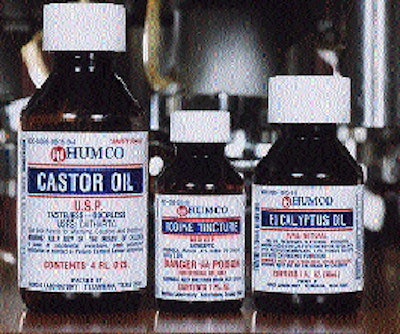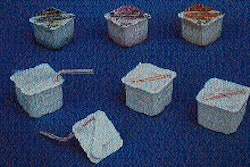When it came time to upgrade liquid filling of 1- to 4-oz glass and plastic bottles, ease and speed of changeover was at the top of Humco's shopping list. That's because Humco Holding Group produces more than 350 SKUs, mostly under its own label. The Texarkana, TX, firm found what it needed in a sanitary piston filler from Serac (Carol Stream, IL). "Our niche is over-the-counter pharmaceuticals, 'wets and dries,' as they call it here in the business," says president Tom DeGreve. "Rubbing alcohol, hydrogen peroxide, epsom salts-that's what we fill. Among our competitors, few have a line of products as wide as we offer. Our strategy is to be as competitive as we can on the high-volume products, where we have no shortage of competition, while still offering such a wide range that we can maintain our position as a sort of 'one-stop shopping' supplier." Humco typically runs a product for two or three days, two shifts per day. But when it's time to change, there's no time to lose, and that's where the Serac filler comes in. "Our previous filler required two or three people and up to four hours before it was cleaned and ready for a new product," says DeGreve. "Now it takes less than two hours practically unattended, even though some of our products, like iodine for example, are difficult to clean. And that will improve as we get further along the learning curve. We're still finalizing some of our settings, things like detergent strengths and rinsing times." Maintenance tasks and downtime are significantly reduced, too, says DeGreve, because the machine is built without O-rings or seals in the product path, including the piston cylinder measuring assembly. The precision-ground stainless steel is machined to function on a metal-to-metal basis. Eliminating seals and O-rings is especially significant because some of Humco's products, like clove or cinnamon oils, can react with the rubber-based materials used to make seals. "The 16-head vacuum pressure filler we had before had something like four O-rings per filling head," says DeGreve. "The mechanical motion of the fill cycle caused steady friction that wore the O-rings out. It was made much worse because some of our products attacked the rubber-based material of the O-ring and caused it to swell. That only hastened their disintegration." Seeking the right system The search for a new filler took DeGreve and his production and maintenance people on several site inspection tours to observe various machines. They nearly settled on an in-line filler, but ultimately they selected an eight-head rotary machine. In addition to minimal maintenance and easy cleaning, the filler provides accuracy to within ±0.25% and all the speed that was required. "Even though we halved the number of fill heads compared to the vacuum filler we were replacing, we still fill at the same speeds because the cycle of each fill is much shorter," says DeGreve. Filling speeds vary according to what's being filled. According to production line leader Pam Golston, thin liquids can be filled at up to 95/min; more viscous products slow it down. However, when application daubers are being manually inserted into the 1-oz bottles, speeds are closer to 75/min. An automatic inserter being built in-house will eliminate hand insertion of the daubers. While speed and accuracy were significant to DeGreve, it's the CIP capability that puts a smile on his face. "Other fillers we looked at had CIP, too, but some were little more than a forward flush followed by the product you're changing to," says DeGreve. "This system has a spray ball inside the filling bowl that shoots out a high-pressure jet spray as the pistons move up and down." For oily products, cleaning begins with a wash cycle of alcohol to break down residue. With most products, cleaning is a three-step process. First is a hot detergent solution, followed by a rinse cycle with deionized water. Finally, the machine is flushed with 99% isopropyl alcohol to remove residual odors and facilitate drying. The deionized water is plumbed directly into the machine. The other two solutions are wheeled up to the machine in 25-gal containers. "The machine does everything after that automatically," says DeGreve. "It brings in the detergent, runs it through, drains it, and then brings in the next two solutions the same way." According to Golston, cleaning the old filler required too much connecting and disconnecting of hoses. "Now we just wheel out the solutions, connect the intake hoses, press a few buttons and let it clean itself," she says. More change Currently both glass and high-density polyethylene bottles are run on the machine. Some products aren't compatible with HDPE, says DeGreve, which is why glass is part of the mix. But it won't be for long. Nor will HDPE. Humco is switching from glass and HDPE to bottles of polyethylene terephthalate. "We were able to find a stock four-ounce bottle that met our requirements, but not the other two sizes," says DeGreve. "So those we'll have produced on a custom basis." Owens-Brockway (Toledo, OH) will produce the new bottles. Humco retains the same injection-molded polypropylene closures and paper pressure-sensitive labels. The new PET bottles will be lighter, cheaper and less likely to break than glass. Compared to HDPE, PET will be more expensive. But they'll be worth it, says DeGreve. "We've not been completely happy with the stability of the small bottles we've been using," he says. "By producing from a custom mold, we'll be able to correct that." Anticipating the elimination of glass bottles, DeGreve also has installed an automated bottle unscrambler supplied by Palace (West Chester, PA). "It does a great job already," says DeGreve. "When we're into all plastic containers, we'll really be able to take full advantage of it."


























